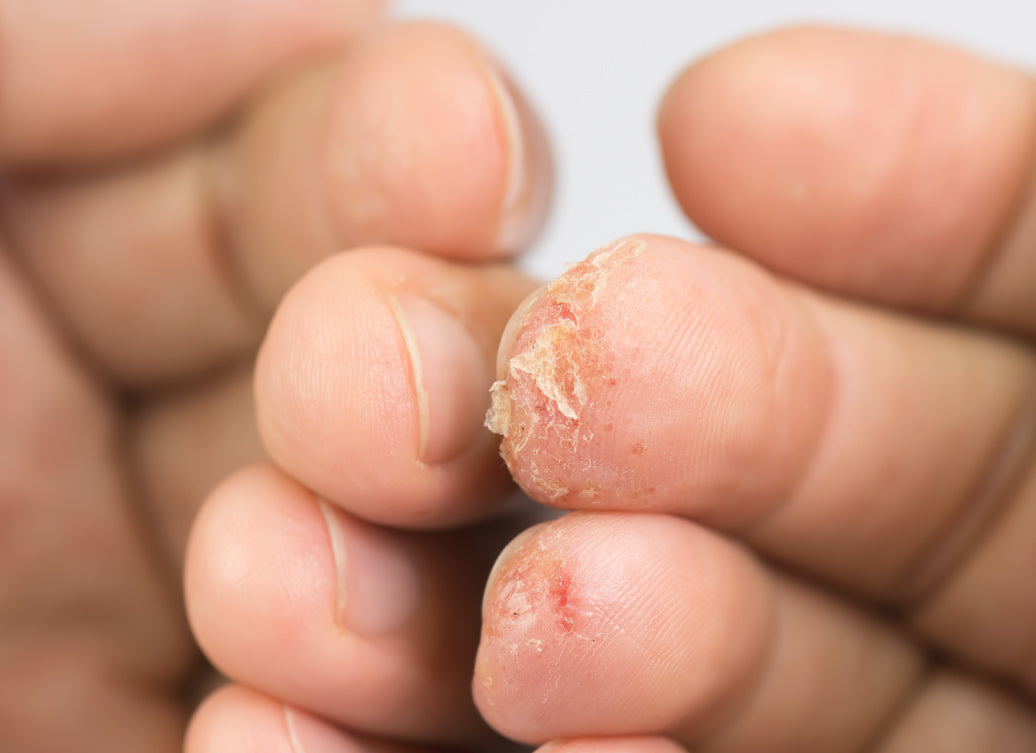Dyshidrosis is a type of eczema that usually affects the fingers, hands and sometimes feet. It can be relatively hard to manage, so if you’re prone to flares of the condition it’s worth looking at what you can do to prevent it happening again!
What is dyshidrosis?
Also known as pompholyx or dyshidrotic eczema, dyshidrosis is characterised by an outbreak of tiny, itchy blisters across the skin of the hands and/or feet. For most people, an outbreak lasts for about three to four weeks, and cycles through an itchy stage, to an eruption of fluid-filled blisters, ending with the skin drying out (which often involves painful cracking) and eventually healing.
While for many people dyshidrosis might be a one-off flare, or at least a relatively infrequent condition, for other more unfortunate sufferers their dyshidrosis is ongoing, and they can find there’s very little in the way of a break between cycles of flaring and healing. Most of those who get dyshidrosis find themselves somewhere in between, with times when their hands or feet are worse, but also times when their skin is completely clear.
What’s the best way to manage dyshidrosis?
While you’re unlikely to be able to cure dyshidrosis for good, it’s possible to manage the condition with strategies that can help reduce the severity and frequency of flares.
The aim of a dyshidrosis management plan is twofold: looking after your skin as best as possible, and getting into the habit of avoiding the things that could trigger the condition.
Let’s look at how that might work for you.
Know your skin
Of course, everyone’s skin is as unique as they are, so you might find what flares you up isn’t the same as what might trigger an attack of dyshidrosis in someone else. We’d recommend keeping a diary, jotting down everything you put on your skin, and noting other possible factors that could be causing your skin to break out. Consider anything you come into contact with, however unexpected! Nickel and cobalt are common causes of dyshidrosis, for example, and these metals can turn up in all sorts of places, from jewellery to mobile phones, even the food you eat. Other potential culprits include concrete, oils, industrial detergents, dirt, and hand sanitisers.
Check your soap!
Have a close look at what you’re washing your hands with: are you using ordinary household soap, for example? Bar soap usually has a pretty high ph level which can scour the skin, stripping natural oils from its surface and leaving its barrier damaged. Likewise, most hand washes contain synthetic perfumes, dyes, and sodium lauryl sulphates, all of which can irritate the skin in a similar way. Choose unfragranced, SLS-free, ph-neutral products instead, like Balmonds Natural Shampoo & Body Wash, an extra-gentle all-purpose wash which can be used on hands, face and body without irritating skin.
Keep your cool
Heat is not great for dyshidrosis, unfortunately. Many sufferers find their condition worsens in the heat; their flares can last all summer long, and resolve in the colder months of the year. You might find it helps to keep your hands or feet cool with ice packs or cold compresses, though be aware that prolonged exposure to water (ie soaking them in cold water) can also aggravate a flare of dyshidrosis. Feet and hands that are sweaty, hot and bothered can take longer to heal.
Keep dry
Water can exacerbate flares, so make sure your hands are kept dry, cool, and protected as much as possible. It’s sensible to take precautions to avoid getting your hands hot and damp: wear gloves if you’re working with irritant substances, but make sure the gloves are dry (rather than sweaty) inside. You may need to wear cotton gloves inside waterproof ones, to keep your hands dry but not irritated.
Pat your hands dry with a soft, clean paper towel or shammy towel after you’ve washed them, and put your moisturiser on immediately after that!
Manage your stress
It might not be as obvious a factor in a case of dyshidrosis as cosmetics or detergents, but stress can play a significant part in how often you flare, and how long the flare lasts. Find ways of managing your stress or anxiety if at all possible, whether that’s a daily five minutes with a meditation app, or long walks in the woods.
Eat well
Your body needs nutrients to repair the broken skin barrier of dyshidrosis; fuel it well! In practice this might mean plenty of green leafy veg, oily fish, berries, and protein such as nuts (if you aren’t allergic to them!), seeds, and tofu.
Keep moisturised
Although damp isn’t great for skin prone to dyshidrotic eczema, you do need to help support your skin’s barrier by using rich, unfragranced emollients, even when you’re not flaring. What this does is keep your skin in healthy enough condition to resist damage from irritants and other triggers. So keep slathering on the lotions and potions even between flares!
What products are good for dyshidrotic skin?
Balmonds Natural Shampoo & Body Wash
with calendula & chamomile
Balmonds Skin Salvation
with hemp and beeswax
Balmonds Cooling Cream
with shea, menthol, aloe vera & lavender
Balmonds Scalp Oil
with tea tree, nettle, borage & rosemary
